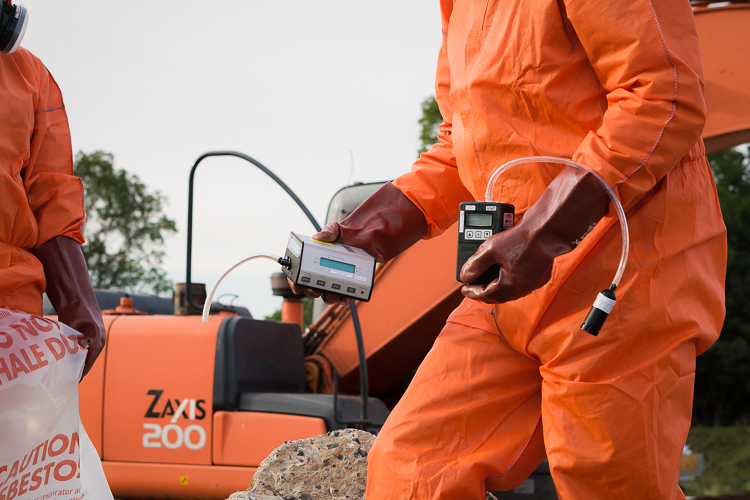Expert Tips for Conducting Dependable Asbestos Testing in Buildings and Structures
In the world of structure maintenance and safety and security, the value of conducting dependable asbestos testing in structures can not be overemphasized. Recognizing the nuances of asbestos screening, such as the various tasting strategies and the vital differences between Do it yourself testing and professional solutions, is vital for ensuring precise results.

Relevance of Asbestos Checking
Carrying out asbestos screening in structures and frameworks is crucial for protecting the wellness and wellness of passengers and workers. Asbestos Testing. Asbestos, when a popular structure product known for its fireproof properties, has given that been connected to severe wellness dangers, including lung cancer cells and mesothelioma. Asbestos-containing products, if left undisturbed, may not pose an instant danger. When these products are damaged or degrade over time, they can release asbestos fibers into the air, which, if inhaled, can lead to extreme wellness difficulties.

Experiencing Techniques
Asbestos screening in structures and structures requires precise tasting strategies to properly examine the visibility and condition of asbestos-containing products. Testing for asbestos should be carried out by trained professionals complying with rigorous guidelines to make sure reputable outcomes. One frequently utilized tasting strategy is the point counting approach, where examples are collected from various building materials thought to contain asbestos, such as insulation, ceiling floor tiles, or floor covering. These samples are then evaluated under a microscope to establish the asbestos web content properly. One more approach is bulk tasting, which includes taking larger examples of materials for analysis. It is necessary to collect representative examples from various areas of the building, as asbestos focus can vary. Additionally, air tasting may be performed to examine asbestos levels in the air, particularly throughout improvement or demolition activities that might interrupt asbestos-containing materials. Using the right tasting methods is crucial for obtaining specific asbestos testing outcomes and ensuring the safety of passengers in structures and structures.
DIY Testing Vs. Professional Services
When thinking about asbestos testing for buildings and frameworks, the selection in between do-it-yourself (DO IT YOURSELF) testing and expert solutions is a critical choice that can impact the accuracy and integrity of the outcomes. Do it yourself testing packages are readily available for acquisition, using a cost-effective choice for individuals seeking to analyze the existence of asbestos in their building. These kits normally include directions on just how to collect samples, which are after that sent out to a research laboratory for analysis. While DIY screening may look like a hassle-free selection, it is important to note that the results may not constantly be as precise as those acquired via professional services.

Interpreting Examination Results
The precision and reliability of asbestos test results, whether obtained through professional solutions or DIY screening, play a vital role in determining the following steps for handling prospective asbestos hazards in buildings and structures. Examination results typically indicate the visibility or lack of asbestos fibers in the experienced materials, along with the concentration of asbestos present if it is spotted. Correct interpretation of asbestos examination results is critical for ensuring the safety of passengers and employees in the building and conforming with asbestos laws and guidelines.
Threat Management Strategies
Successfully executing proactive risk monitoring strategies is essential for safeguarding residents and workers in buildings with possible asbestos dangers (Asbestos Testing). To start, conducting extensive risk assessments is important to identify the presence of asbestos-containing products (ACMs) and analyze the level of risk they pose. This entails evaluating the structure, accumulating examples for testing, and evaluating the results to figure out the ideal strategy
As soon as the visibility of ACMs is confirmed, it is necessary to develop and apply a comprehensive administration plan that describes procedures for handling and controlling asbestos dangers. This plan should include steps such as asbestos encapsulation, elimination, or recurring monitoring to stop exposure and reduce wellness threats. In addition, establishing clear communication networks to educate passengers and employees regarding the existence of asbestos and the safety measures in location is vital for guaranteeing their safety and security.
Normal monitoring and review of asbestos risks are also vital parts of effective danger monitoring techniques. By remaining aggressive useful link and attentive, structure owners and supervisors can create a risk-free setting and stop prospective asbestos-related wellness dangers.
Conclusion
Finally, conducting trustworthy asbestos screening in buildings and frameworks is crucial for determining prospective health and wellness threats and ensuring safety and security. By adhering to appropriate sampling methods, thinking about the benefits of expert services over DIY testing, interpreting examination results accurately, and applying effective risk management strategies, individuals can efficiently manage and alleviate the dangers related to asbestos direct exposure. It is essential to prioritize safety and stick my review here to rigorous screening procedures to secure the well-being of passengers and workers.
Comments on “Asbestos Testing: Important Steps for a Safe Living Atmosphere”